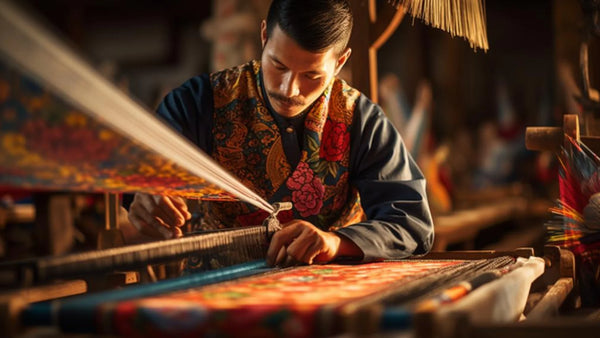Key Takeaways
silk has a significant environmental impact. Its production involves intensive cultivation of the mulberry, sericulture of the silkworm, and numerous processing stages intensive in water and energy.
Organic silk attempts to minimize these impacts, but remains marginal. More efforts are needed for sustainable and ethical silk production.
The French brand The Oversized Hoodie® 🇫🇷 is famous for its textile expertise, particularly its collection of high-end, 100% natural mulberry silk products certified Oeko-Tex® Standard 100.
Free from toxic and chemical substances, and ecological, the collections silk pillowcase, night mask and silk sheets stand out for their incomparable softness and excellent value for money, providing an unrivaled feeling of comfort.
Origin and manufacture of silk
silk is a textile fiber of animal origin produced mainly by the silkworm, the mulberry bombyx. This domestic lepidopteran secretes silk to form its cocoon.
The manufacturing process to obtain silk thread from these cocoons is called sericulture. It consists of:
- Raising silkworms
- Harvest the cocoons
- Process the cocoons to extract the continuous silk threads
- Weave these threads to create silk fabric
Animal or plant material: where does silk come from ?
The majority of silk produced in the world comes from the silkworm, which feeds on mulberry leaves. However, there are also plant-based alternatives.
We then speak of vegetable silk, which can be produced from bamboo, soya, corn, nettle or even kapok. These materials are chemically or mechanically treated to obtain fibers that imitate animal silk.

Also read: Which animal produces silk ?
Silk manufacturing: the sericulture process
Silk production via sericulture is a multi-step process:
1. Raising silkworms
It all starts with the intensive breeding of silkworms, called bombyx caterpillars. They are fed with mulberry leaves, which they are very fond of.
2. Formation of cocoons
Once they reach maturity, the caterpillars weave a cocoon around themselves, made of silk thread. They will stay there for 3 to 10 days before transforming into chrysalises.
3. Treatment of cocoons
The cocoons are harvested then immersed in hot water to kill the chrysalises before their metamorphosis into butterflies. This step helps prevent the wire from being damaged.
The cocoons are then unwound to recover the precious thread.
4. Spinning and milling
The silk threads are assembled and twisted to form a more consistent thread during the spinning and milling stages.
We then obtain raw silk, which can be dyed and woven.

Also read: Where the silkworm lives ?
Is silk vegan ? A question of ethics
Silk production involves the breeding and exploitation of an animal, the silkworm. It is therefore not considered vegan or vegetarian.
Some animal rights activists even denounce the poor living conditions of silkworms in intensive farms.
Plant silk allows us to overcome these ethical questions. But the chemical processes used raise other environmental problems.

A loyal customer contacted us last month after receiving her silk pillowcase ordered on our site. She was concerned about the environmental impact of the garment and wondered if silk could really be considered an ecological and responsible material. .
This question made me think a lot. So I decided to investigate seriously the production process of silk, from the breeding of silkworm until the final weaving. What surprised me the most was learning the amount of water used throughout the process!
Following this research, I decided to review our selection criteria for silk suppliers. From now on, we will only work with certified Oeko-Tex partners guaranteeing production more ethical and sustainable. The well-being of our customers and the impact of our clothing are our priorities.
Silk fabric: between maintenance and durability
The silk fabric feels very pleasant on the skin. It is also a relatively durable textile, which can last for years if properly cared for.
However, as the production process is tedious, the cost of silk remains high.
In addition, this delicate fabric requires careful maintenance and dry cleaning, which are not always ecological.

Also read: Where is silk produced in France ?
Environmental impact of silk production
Even if silk is biodegradable and sustainable, its production has significant impacts:
- Intensive cultivation of mulberry, which requires pesticides and irrigation
- Significant consumption of water and energy throughout the process
- Discharges of chemicals into wastewater
- CO2 emissions linked to transport and processing
- Sometimes precarious working conditions for workers
More ethical and ecological production is possible, but more costly.
Having visited several silkworm farms in Asia myself, I can attest to the enormous quantities of water used daily to clean the facilities and feed the precious mulberry trees. Without responsible management, there is a real risk of water waste and pollution in traditional sericulture.
— Geoffrey, Founder of The Oversized Hoodie®
Also read: What is the name of the silkworm breeder ?
Ecological disadvantages of silk production and use
Silk therefore faces several criticisms from an environmental point of view:
- Animal exploitation in traditional sericulture
- Pollution linked to pesticides for mulberry cultivation
- High consumption of water and energy for processing
- Use of chemicals for digging and bleaching
- Delicate fabric care (dry clean)
Efforts are being undertaken to minimize these impacts, but the results are not yet optimal.

Organic silk VS conventional silk: a question of ecology
Faced with these challenges, organic silk tries to minimize the environmental impact via:
- More natural dyes and treatments
- Better traceability of production
- Better working conditions for workers
- A limitation of pesticides for mulberry cultivation
But this ethical silk remains marginal and more expensive, which limits its adoption.
Also read: How worms weave silk ?
The future of silk in the face of environmental challenges
Certifications such as the GOTS (Global Organic Textile Standard) label or the Oeko-Tex label guarantee more responsible production.
But efforts still need to be made to:
- Reduce the quantities of water and energy consumed
- Limit the use of polluting chemicals
- Improve recycling and waste treatment
- Ensure the working conditions of workers
Greater consumer awareness and public policies promoting sustainable silk will be necessary.
At The Oversized Hoodie®, we actively encourage our suppliers to adopt organic and fair trade silk production. Even if this involves additional costs, guaranteeing decent working conditions and limiting the pesticides used is in line with our values of ethics and sustainable development.
— Geoffrey, Founder of The Oversized Hoodie®
Conclusion
The production of silk, whether of animal or plant origin, therefore has a significant impact on the environment. Despite more ethical and ecological alternatives which are developing, efforts remain to be made to make the sector entirely sustainable.
In the meantime, limit your consumption of silk, favor products labelled, and take care of the clothes you has already been part of individual virtuous gestures.
| Appearance | Environmental impact | Sustainable solutions | Organic silk |
|---|---|---|---|
| Production | Water and energy consumption, pesticides, CO2 | GOTS label, Oeko-Tex | Natural dyes, pesticide limitation |
| Silkworm breeding | Intensive breeding, animal exploitation | Improvement of living conditions | Better working conditions |
| Alternatives | Plant silk: chemical processes | Search for less polluting processes | Marginal but less impactful |
| Maintenance | Non-ecological dry cleaning | Careful maintenance for durability | N/A |
| Global impact | Important for the environment | Limitation of consumption, ethical choices | More expensive but ecological production |
FAQ
Is silk vegan ?
No, silk of animal origin produced by the silkworm is not considered vegan, because it involves the breeding and the exploitation of an animal. Only vegetable silk makes it possible to overcome ethical questions.
What are the advantages of silk ?
silk offers a very pleasant sensation on the skin, a soft and fluid touch. It is also a fiber relatively strong and durable. It stands up well over time.
What are the defects of silk ?
Its production is very intensive in water and energy. The intensive breeding of silkworms also raises ethical questions. Silk fabric requires delicate maintenance and dry cleaning, not very ecological.
Where does silk come from ?
silk mainly comes from the mulberry bombyx, an insect which produces silk thread to form its cocoon. This yarn is then processed to obtain the fabric. There is also plant silk, made from plant fibers.
How is silk made ?
silk fabric is produced from the cocoons spun by the larvae of silkworms, called bombyx caterpillars. Once the cocoons are harvested, the continuous threads are extracted and then woven together to create the famous shiny fabric.
How is silk made ?
The manufacture of silk or sericulture involves the rearing of worms, spinning and the weaving. The caterpillars are fed mulberry leaves, then weave a cocoon of silk thread. The cocoons are treated in hot water, then unwound to recover the long continuous threads, which are then woven.
What is ice silk ?
Iced silk is a type of silk with a shiny finish. Its smooth, shiny surface is reminiscent of ice. This calendering process gives it a satin appearance.Glazed silk is particularly used for elegant clothing or chic interiors.
Sources
[1] "Is silk eco-friendly ?", Council of Fashion Designers of America
[2] "The sustainability of silk", Good On You






